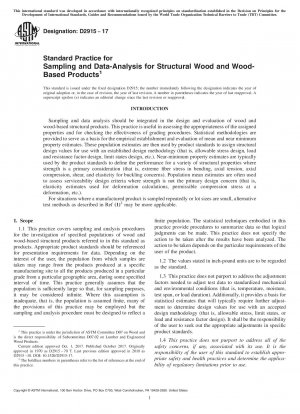ASTM D2915-17
Standard Practice for Sampling and Data-Analysis for Structural Wood and Wood-Based Products
- Standard No.
- ASTM D2915-17
- Release Date
- 2017
- Published By
- American Society for Testing and Materials (ASTM)
- Status
- Replace By
- ASTM D2915-17(2022)
- Latest
- ASTM D2915-17(2022)
- Scope
- 1.1 This practice covers sampling and analysis procedures for the investigation of specified populations of wood and wood-based structural products referred to in this standard as products. Appropriate product standards should be referenced for presentation requirements for data. Depending on the interest of the user, the population from which samples are taken may range from the products produced at a specific manufacturing site to all the products produced in a particular grade from a particular geographic area, during some specified interval of time. This practice generally assumes that the population is sufficiently large so that, for sampling purposes, it may be considered infinite. Where this assumption is inadequate, that is, the population is assumed finite, many of the provisions of this practice may be employed but the sampling and analysis procedure must be designed to reflect a finite population. The statistical techniques embodied in this practice provide procedures to summarize data so that logical judgments can be made. This practice does not specify the action to be taken after the results have been analyzed. The action to be taken depends on the particular requirements of the user of the product. 1.2 The values stated in inch-pound units are to be regarded as the standard. 1.3 This practice does not purport to address the adjustment factors needed to adjust test data to standardized mechanical and environmental conditions (that is, temperature, moisture, test span, or load duration). Additionally, it provides a basis for statistical estimates that will typically require further adjustment to determine design values for use with an accepted design methodology (that is, allowable stress, limit states, or load and resistance factor design). It shall be the responsibility of the user to seek out the appropriate adjustments in specific product standards. 1.4 This practice does not purport to address all of the safety concerns, if any, associated with its use. It is the responsibility of the user of this standard to establish appropriate safety and health practices and determine the applicability of regulatory limitations prior to use. 1 This practice is under the jurisdiction of ASTM Committee D07 on Wood and is the direct responsibility of Subcommittee D07.02 on Lumber and Engineered Wood Products. Current edition approved Oct. 1, 2017. Published October 2017. Originally approved in 1970 as D2915 – 70 T. Last previous edition approved in 2010 as D2915 –10. DOI: 10.1520/D2915-17. 2 The boldface numbers in parentheses refer to the list of references at the end of this practice. Copyright © ASTM International, 100 Barr Harbor Drive, PO Box C700, West Conshohocken, PA 19428-2959. United States This international standard was developed in accordance with internationally recognized principles on standardization established in the Decision on Principles for the Development of International Standards, Guides and Recommendations issued by the World Trade Organization Technical Barriers to Trade (TBT) Committee. 1 1.5 This international standard was developed in accordance with internationally recognized principles on standardization established in the Decision on Principles for the Development of International Standards, Guides and Recommendations issued by the World Trade Organization Technical Barriers to Trade (TBT) Committee.
ASTM D2915-17 Referenced Document
- ASTM D198 Standard Test Methods of Static Tests of Lumber in Structural Sizes
- ASTM D1990 Standard Practice for Establishing Allowable Properties for Visually-Graded Dimension Lumber from In-Grade Tests of Full-Size Specimens*, 2019-10-01 Update
- ASTM D245 Standard Practice for Establishing Structural Grades and Related Allowable Properties for Visually Graded Lumber*, 2022-02-01 Update
- ASTM D2555 Standard Test Methods for Establishing Clear Wood Strength Values
- ASTM D3737 Standard Practice for Establishing Allowable Properties for Structural Glued Laminated Timber (Glulam)*, 2018-04-01 Update
- ASTM D5055 Standard Specification for Establishing and Monitoring Structural Capacities of Prefabricated Wood I-Joists*, 2019-03-01 Update
- ASTM D5456 Standard Specification for Evaluation of Structural Composite Lumber Products
- ASTM D6570 Standard Practice for Assigning Allowable Properties for Mechanically Graded Lumber*, 2018-10-01 Update
- ASTM D9 Standard Terminology Relating to Wood
- ASTM E105 Standard Practice for Probability Sampling Of Materials*, 2024-04-21 Update
- ASTM E29 Standard Practice for Using Significant Digits in Test Data to Determine Conformance with Specifications
ASTM D2915-17 history
- 2022 ASTM D2915-17(2022) Standard Practice for Sampling and Data-Analysis for Structural Wood and Wood-Based Products
- 2017 ASTM D2915-17 Standard Practice for Sampling and Data-Analysis for Structural Wood and Wood-Based Products
- 2010 ASTM D2915-10 Practice for Sampling and Data-Analysis for Structural Wood and Wood-Based Products
- 2003 ASTM D2915-03 Standard Practice for Evaluating Allowable Properties for Grades of Structural Lumber
- 2002 ASTM D2915-02 Standard Practice for Evaluating Allowable Properties for Grades of Structural Lumber
- 1998 ASTM D2915-98e1 Standard Practice for Evaluating Allowable Properties for Grades of Structural Lumber
